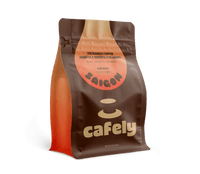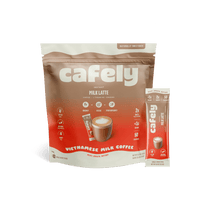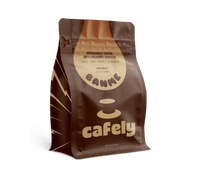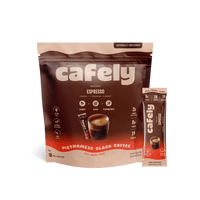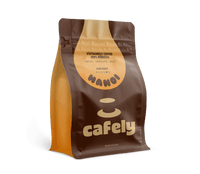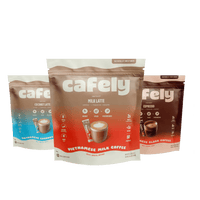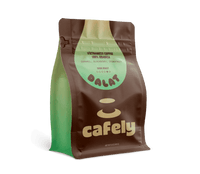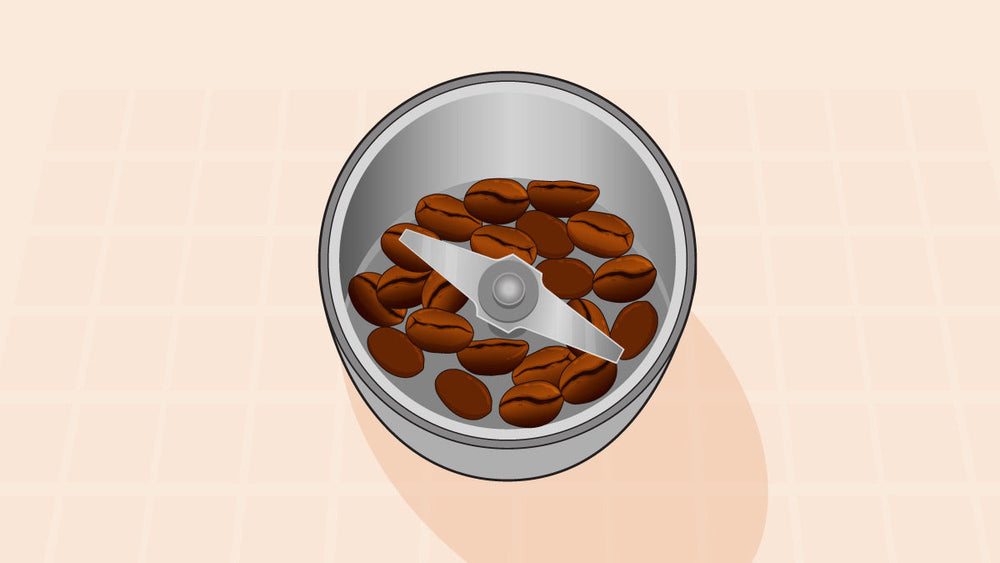Have you noticed your cup of coffee tastes off? An unclean grinder may be to blame. Old, stale coffee grounds and residue can build up in your grinder and stick to any fresh coffee you grind.
Whether blade or burr, it’s important to know how to clean your coffee grinder to prevent your brews from losing quality over time. We’ll take you through everything you need to know, from how to deep clean your coffee grinder to regular cleaning and maintenance tips.
How to Identify Your Coffee Grinder: Blade or Burr?
Before cleaning your grinder, it’s important to know what type you have.
Blade grinders use rotating blades to chop beans, similar to a small blender. If you see sharp blades inside, it's a blade grinder.
Burr grinders use two grooved metal or ceramic burrs to crush beans for a more consistent grind, ideal for espresso. They’re usually larger and more expensive. If there are no blades but a stone-like mechanism, it’s a burr grinder — either flat or conical in shape.
How to Clean a Blade Coffee Grinder
If you want to ensure your blade grinder continues to perform well, you’ll need to clean and maintain it regularly.
Below, we take you through the rice method — the most common way to clean your blade coffee grinder:

The rice method is a quick, cheap, and easy way to keep your grinder clean. It’s a great method to thoroughly clean your grinder without disassembly.
- Add a quarter of a cup of uncooked white rice to the grinder hopper and secure the lid.
- Grind the rice as you would coffee until a medium-fine grind (similar to table salt) is produced.
- Discard the powdered rice.
- Wipe away any remaining rice residue from the inside of the hopper with a microfiber towel.
- Grind a small amount of coffee to a medium-fine consistency and discard to remove any remaining rice powder.
How to Clean a Burr Coffee Grinder
Burr grinders work differently to blade grinders, as they’re essentially two similarly-shaped discs pressing beans together to crush them into a powder. Unfortunately, they’ll require a more intense cleaning — the pressures used in the crushing process can lead to more residual buildup.
Here’s how to deep clean your burr grinder:
1. Disassemble the Burr Grinder
The first part of cleaning a coffee grinder is disassembling it as much as possible. Burr grinders are usually designed with this process in mind, so the manufacturer will typically include instructions on how to disassemble the grinder.
Here are some general instructions for disassembly:
- Unplug the grinder from the outlet before starting.
- Remove the lid from the bean hopper and the grind collection bin.
- Remove any beans that may still be within the grinder, and discard.
- Remove the inner burr. Burrs are typically adjusted to a coarser or finer grind by turning them one way or the other. In most grinders, the burr is removed by first twisting it to maximum coarseness and then gently but firmly continuing to unseat it.
Note: If these directions don't work for you, consult the user manual for your specific burr grinder.
2. Clean the Parts
Now that the parts are separated, you can clean them.
Here’s a step-by-step guide for cleaning your burr grinder:
- Wash any plastic parts (like the hopper) with dish soap and water. Dry these parts with a microfiber towel and allow them to air dry while cleaning the other parts.
- Clean the now-removed inner burr by brushing off any large deposits of ground coffee and then wiping the surface over with a dry microfiber cloth. This should remove both grounds and oil. For stubborn residues, use a mild detergent and a soft sponge.
- Repeat this process with the outer burr. You may need to invert your grinder to tip out any remaining grounds.
- Clean the inside of the coffee chute with a damp cloth. Use a Q-tip to clean hard-to-reach areas.
- Leave the elements to dry fully.
- Once you’re certain the components are all dry, it’s time for reassembly.
3. Reassemble the Burr Grinder
Finally, let's put the grinder back together, ready to make the next cup of coffee:
- Carefully insert the inner burr, and mount it back into place. You’ll probably have to twist it back into the place you found it. It may have a bayonet-style mount (depending on the grinder).
- Once the inner burr is in place, Change the grind level a little either way. If everything seems to be functioning properly, move on to the next step.
- Put the collection chamber back onto the base of the grinder. Then, place the lid back onto the hopper, and you’re good to go.
Why You Should Clean Your Coffee Grinder Regularly
Regular maintenance for such a critical piece of kit as your grinder is vital, as it can immediately impact the quality of your coffee.
Let’s take a look at the main reasons you should clean your grinder regularly:
1. Flavor
The flavor of your coffee will degrade if you don’t regularly clean out the grinder. As the beans pass through the grinder system, they leave behind oils and old grounds. These oils and particles degrade with time and will bring a stale taste to your cup. They could even potentially become moldy if left for too long.
2. Efficiency
The buildup of oil from ground coffee is a concern when producing a fine grind. Finely grinding coffee regularly leaves more oil behind on the burrs in your grinder. These oils will reduce your grinder’s ability to produce consistently fine grinds over time.
A dirty, clogged grinder won’t produce the same grind quality as a clean grinder. An inconsistent grind can lead to over or under-extraction — leaving you with a poor-tasting brew.
3. Longevity
If you don’t clean your coffee grinder oils, grounds, and grime will build up in the inner workings of the grinder. These components will have to work harder, which will lead to them becoming damaged or wearing out much sooner than expected.
To ensure your coffee grinder stays in top shape for as long as possible, regularly clean it. You won’t have to disassemble your grinder after every use, but regular maintenance can prevent wear and tear from having a big impact over time.
Daily and Weekly Tips for Maintaining Your Coffee Grinder

Deep cleaning can be a great way to ensure your grinder is in the best shape possible, but it also takes a lot of time and effort. The best way to minimize this time and effort is to engage in regular upkeep and maintenance.
If you’re looking for a daily practice to ensure your grinder is cleaned, there’s one main rule — grind only what you need and then clean up after yourself.
This is more of a mindset to use when approaching coffee-making, but it can be an effective way to ensure that your grinder stays clean. Instead of emptying your entire bag of beans into the machine, store them in a cool, airtight container and only grind a serving at a time.
Once you’ve ground a scoop of beans, take the lid off the hopper and use a long-handled brush to dislodge any papery skins or small grounds that may be stuck. Do the same with the coffee chute, and you’ll maintain a good level of overall cleanliness on a day-to-day basis.
It’s also a good idea to wash the collection chamber with soap and water and wipe the inside of the bean hopper with a dry microfiber cloth every week. This habit will remove any fine grounds and oil that may be building up.
For most home users, you only need to disassemble and deep clean your coffee grinder once per month. To start a routine and stick to it, add a reminder to your calendar.
Coffee Grinder Cleaning Mistakes You Must Avoid
When cleaning your coffee grinder, it's important to avoid several common mistakes. Avoiding these mistakes can help you to clean well without damaging your coffee grinder at all.
1. Turn Off and Unplug the Grinder Before Cleaning
As much as might seem obvious, it's important to avoid simple mistakes for your safety. With that in mind, be sure to switch your grinder off and unplug it from the power before you do any cleaning.
2. Keep Your Burrs Dry
It’s important that when you clean your burrs, you avoid using too much water. You should be able to wipe your burrs clean with a dry cloth, as long as you disassemble and clean your grinder regularly. However, stubborn oils and residues sometimes require water. If you must use water, make sure the burrs are completely dry before reassembling.
If you reassemble your grinder with wet burrs, they could begin to rust or mold. This will contaminate your coffee and reduce the effectiveness of your grinder.
3. Improper Reassembly
If it’s the first time you’re disassembling and reassembling your grinder, you might not be familiar with the exact steps of putting it back together. As long as you follow the manufacturer's instructions or take note of where the different components go, you shouldn’t have an issue.
If you assemble a grinder improperly, it can be dangerous. If the burrs or blades in your grinder become dislodged from their housing, they could damage the rest of the grinder and turn into a lethal projectile. Take care when reassembling your grinder and make sure you’ve done it properly before switching it on.
4. Using Too Much Force
Grinders are designed to be taken apart and put back together through a specific process. So, make sure that you dig out the instruction manual and follow it closely. This should stop you from damaging a vital component through force.
If a specific part of your grinder won’t detach, don’t use extreme force — chances are it’s not removable.
Choosing the Best Coffee Beans for your Grinder
High-quality beans not only create a tastier cup of Joe, but they’re also kinder to your coffee grinder.
Let’s take a look at some key factors in selecting the ideal beans for you:
- Organic Growing Practices — Organically grown beans have a much better environmental impact than traditionally grown beans. On top of this, choosing organic reduces the risk that your beans may contain chemicals like pesticides.
- Certified Mold-Free — When shipped internationally, some crops can grow a small bit of mold, which can occasionally leave behind some mycotoxins. To ensure that these toxins don’t make their way into your grinder, always make sure that you’re finding certified mold-free beans.
- Country of Origin — The flavor of any coffee is impacted greatly by the country in which that coffee was grown. Vietnamese coffee has a richer, earthier flavor compared to other beans. To ensure consistency of flavor, load your grinder up with the same single-origin coffee each time, or clean it between grinds.
- Strong Flavor and Caffeine Content — An intense caffeine content and powerful flavor are two hallmarks of great coffee. Regular grinder maintenance is important to ensure that you keep the flavor of your beans as authentically explosive as possible. This will prevent cross-contamination between different batches of beans.
- Freshly Roasted — When beans are freshly roasted, they’ve got the most flavor they’ll ever have. Once those beans have been shipped to you and ground, some grinds will likely get stuck within your grinder. These tiny amounts can go stale with time, making fresh coffee taste not as good as it could. To avoid this happening, clean your grinder between bags of coffee beans.
FAQs: Cleaning Your Coffee Grinder
Cleaning your coffee grinder is a vital part of general upkeep, so let’s review some FAQs to ensure we’ve covered all bases.
1. How Often Should I Clean My Coffee Grinder?
If you use your grinder every day, you should do a light clean once per week and a deep clean once per month.
2. Can I Use Rice to Clean my Burr Grinder?
No, that’s not a good idea. Rice can damage the burrs, so this cleaning method is only appropriate for a blade grinder. Instead, use tablets specifically designed to clean burr grinders.
3. Is It Safe to Wash Grinder Parts in the Dishwasher?
The answer to this question depends on your specific grinder. It’s generally best to refer to the manufacturer’s instructions on which parts of your grinder are or are not safe to put in the dishwasher.
4. What Are Grinder Cleaning Tablets?

Grinder cleaning tablets are specialized products designed to be added to a burr grinder. As they are crushed, they remove oils and residue from the grinder, saving you the hassle of disassembling.
5. Can I Grind Spices in my Coffee Grinder?
While you technically grind spices in your coffee grinder, we wouldn’t recommend it. Doing this will likely lead to flavors and aromas lingering within the grinder, which can taint the taste of your coffee.
6. Why Does My Grinder Smell Rancid?
Coffee beans release oils when they’re ground. If there has been a buildup of this oil within your grinder, you may find that it has turned rancid over time. Regular cleaning prevents this from being an issue by preventing buildup.
7. How do I Prevent Static Buildup in My Grinder?
The best way to prevent static buildup is to ensure your grinder is free from any small pockets of grinds in the system. Ensuring proper humidity within the grinder can also help, though this can be difficult to manage while keeping the burrs dry.
8. Can I Use a Vacuum to Clean my Grinder?
Yes, vacuums can be a very helpful way to clean a coffee grinder. Many modern vacuums have attachments designed to get into small spaces. If you have a vacuum with these attachments, using it to clean your grinder can be very helpful.
9. What Tools are Best for Cleaning a Grinder?
You can purchase grinder-specific cleaning kits that are full of the correct tools. The most essential tools are soft brushes with long handles and microfiber cloths. These tools are best for removing built-up grounds in a dry environment.
10. Is Professional Grinder Cleaning Necessary?
If you grind coffee beans commercially, it’s wise to get your grinder maintained and serviced periodically. But if you grind coffee beans at home, you can take care of it yourself.
